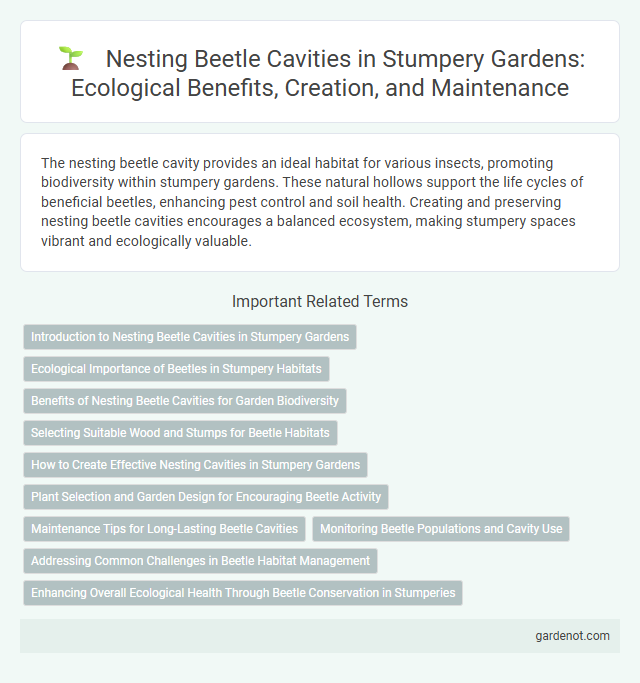The nesting beetle cavity provides an ideal habitat for various insects, promoting biodiversity within stumpery gardens. These natural hollows support the life cycles of beneficial beetles, enhancing pest control and soil health. Creating and preserving nesting beetle cavities encourages a balanced ecosystem, making stumpery spaces vibrant and ecologically valuable.
Introduction to Nesting Beetle Cavities in Stumpery Gardens
Nesting beetle cavities in stumpery gardens provide vital habitats for various beetle species that contribute to natural pest control and soil health. Decaying wood within stumperies creates ideal nesting sites by offering moisture and shelter that support beetle reproduction and larval development. These cavities enhance biodiversity, promoting a balanced ecosystem in garden environments.
Ecological Importance of Beetles in Stumpery Habitats
Nesting beetle cavities in stumpery habitats provide essential microhabitats that support biodiversity by offering shelter and breeding sites for various invertebrates. These cavities facilitate nutrient cycling and soil aeration as beetle larvae break down decaying wood, promoting forest ecosystem health. The presence of beetle cavities enhances natural pest control by supporting predatory beetle species, contributing to balanced ecological interactions within stumperies.
Benefits of Nesting Beetle Cavities for Garden Biodiversity
Nesting beetle cavities provide essential habitats for various beneficial insects, promoting garden biodiversity by supporting pollinators and natural pest controllers. These cavities enhance ecosystem resilience by offering shelter and breeding sites, contributing to a balanced and healthy garden environment. Incorporating nesting beetle cavities in stumperies helps maintain diverse insect populations, which in turn supports plant health and soil quality.
Selecting Suitable Wood and Stumps for Beetle Habitats
Selecting suitable wood and stumps for nesting beetle cavities involves choosing decaying hardwood species like oak, beech, or ash that provide optimal moisture levels and structural complexity. Ideal stumps should have existing fungal colonization to support beetle larvae development and be situated in shaded, undisturbed areas that maintain stable microclimates. Ensuring a diversity of wood decay stages enhances habitat suitability by offering varied cavity sizes and nutritional resources for different beetle species.
How to Create Effective Nesting Cavities in Stumpery Gardens
Effective nesting cavities in stumpery gardens require selecting decayed hardwood logs with natural holes or tunnels approximately 10-15mm in diameter to accommodate nesting beetles. Position cavities in shaded, moist areas within the stumpery to maintain ideal humidity and temperature levels critical for beetle development. Incorporating a variety of log sizes and orientations enhances habitat diversity, attracting multiple beetle species and promoting ecological balance.
Plant Selection and Garden Design for Encouraging Beetle Activity
Selecting native ferns, mosses, and decaying wood-rich plants creates an ideal habitat for nesting beetle cavities within stumperies. Incorporating diverse plant species with varied textures and moisture levels enhances microhabitats that promote beetle foraging and breeding behaviors. Strategic garden design featuring shaded, humid conditions and ample organic matter supports beetle diversity and increases beetle activity in stumpery environments.
Maintenance Tips for Long-Lasting Beetle Cavities
Regularly inspect beetle cavities for moisture buildup to prevent wood decay and fungal growth, ensuring a dry, well-ventilated environment. Use natural oils or eco-friendly sealants to protect the cavity surfaces from weathering and extend their durability. Removing debris and monitoring for insect infestations maintains optimal conditions for nesting beetles and supports a thriving stumpery ecosystem.
Monitoring Beetle Populations and Cavity Use
Monitoring beetle populations in stumperies involves tracking nesting beetle cavity occupancy to assess habitat quality and biodiversity health. Regular cavity inspections and automated sensors provide data on beetle species presence, nesting frequency, and reproductive success. This information helps inform conservation strategies and habitat management to support sustainable beetle populations.
Addressing Common Challenges in Beetle Habitat Management
Nesting beetle cavities require carefully managed microhabitats that mimic natural decaying wood environments to support beetle breeding and larval development. Maintaining proper moisture levels and preventing fungal overgrowth are critical challenges in beetle habitat management that directly impact cavity suitability. Implementing controlled ventilation and regular monitoring of cavity conditions can significantly enhance nesting success rates in stumpery settings.
Enhancing Overall Ecological Health Through Beetle Conservation in Stumperies
Nesting beetle cavities in stumperies create essential microhabitats that support biodiversity by providing shelter for various invertebrates and fungi. These cavities enhance soil health through the decomposition processes facilitated by beetle activity, promoting nutrient cycling within the ecosystem. Conserving beetle populations in stumperies strengthens ecological resilience and contributes to the stability of woodland habitats.
Nesting beetle cavity Infographic

 gardenot.com
gardenot.com